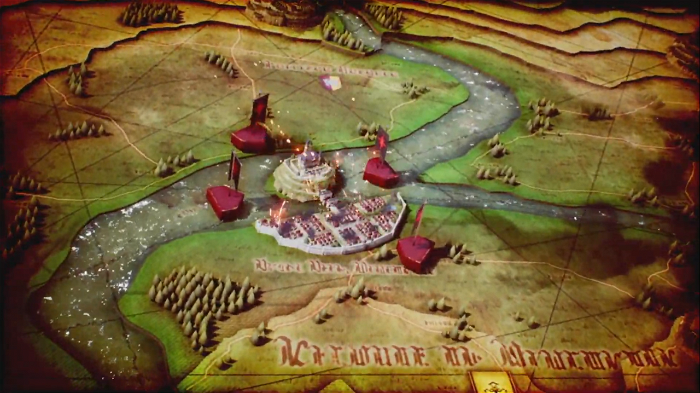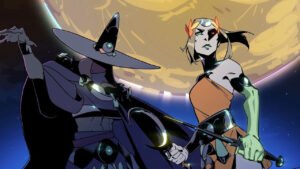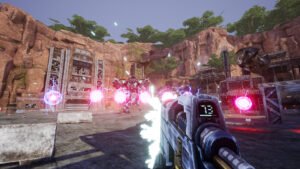Last week’s Nintendo Direct saw the unveiling of Square Enix’s next game in its HD-2D series Project Triangle Strategy. Not only did it follow in the reins of its predecessor, Octopath Traveller, by having an awkward placeholder title, it similarly saw the release of a demo on the Nintendo eShop to let those curious try out an early preview of the game. Unlike Octopath Traveller, however, Project Triangle Strategy is a tactical role-playing game in the vein of Final Fantasy Tactics, Ogre Battle, and their ilk.
As someone who greatly enjoys that style of game, I dove into the demo looking to see what Project Triangle Strategy had to showcase. It’s important to note that the final game is subject to change, particularly since a survey will be released in the future soliciting feedback. That said, there’s already plenty to gleam based on my two playthroughs of the demo, and I walk away feeling tentatively excited.
Story & Presentation
Project Triangle Strategy’s’ demo warns you at the outset that it takes place in the middle of the story, and that it may be difficult to understand what is going on. It’s a fair warning, and I understand that the developers chose to use a gameplay slice not from the beginning to better showcase the battle system.

That being said, why was there the need to include a rather lengthy set of story sequences before the first battle even began? The plot itself seems fine, with it set against the backdrop of three nations reigniting the flames of conflict after a short period of peace, and I am interested in learning more about the world in the future. I suspect there will be a great deal of political intrigue in the narrative, but that is not what is properly conveyed in the demo.
What is easy to glean, however, is that the voice acting needs work. It ranges from perfectly acceptable, to what sounds like a bad first take at an audition, often in the same cutscene. It’s clear from the demo that Project Triangle Strategy will have dozens upon dozens of characters, making improving the quality of the voice acting a must over the next year.
And while I am reserving judgement on the quality of the story until the game releases in 2022, I am concerned about its pacing. Specifically, there are a large number of cutscenes that take place in between battles. At the end of each cutscene, the player is taken back to the world map to choose yet another cutscene. This happens frequently, especially since a lot of the scenes are less than a minute in length. It disrupts the flow of the demo, and I hope it doesn’t go on to disrupt the flow of the game itself.
The Battle System
Fortunately for Project Triangle Strategy, its battle system is very intriguing from what time I’ve spent with it. If you’ve played Final Fantasy Tactics, you know the basics of how this works. A character’s speed determines the order in which they act, whereupon they move around a grid-based battlefield to perform actions. Most characters can move and perform one action, and each character has a different class or job with different abilities. At the end of a turn, you choose the direction a character faces, as being attacked in the back or the side is more effective. Again, straightforward parts of the genre.

Where it starts to get interesting is in positioning. Project Triangle Strategy features combination attacks, where characters that are on opposite sides of a unit can chain attacks quickly. And being attacked in the back results in an automatic critical hit. Despite the high health of the foes in the demo, by making the most out of proper movement and positioning you can easily handle them. Of course, the same is true of the enemy, and the interplay between pushing forward to surround an opponent vs. holding back to avoid the risk of being cut off promises to play a major factor in battle.
I also loved how skills worked in the demo. Each unit starts a battle with one TP, which increases automatically at the end of a character’s turn and by performing specific actions such as a backstab, combination attack, or killing an enemy. Importantly, this is true of mages as well, which means that they can still be useful the longer a fight goes on because they don’t need to worry about running out of MP mid-battle.
One of the questions left unanswered by Project Triangle Strategy is what form a job or class system it has. Each controllable character has a unique class, such as Soldier, Spear Knight, etc., and there’s no indication if characters can switch between them. The classes as they exist in the game are intriguing, with very different abilities that offer a number of strategic options. The Spy class is my personal favourite, as it can act twice each turn but compensates for this by having the lowest health amongst the party.
Voting & Final Thoughts
An emphasized point in Project Triangle Strategy’s reveal is that the story changes depending on how the player responds to branching dialogue choices. The three attributes — Utility, Morality, and Liberty — were not telegraphed in the demo, either before or after an answer was chosen. And being a demo, there was really no way to showcase this system in full.

But what is demonstrated is how the game will handle important decisions. Occasionally, the party will come together to vote on an important decision that will change the course of the story. Even if the player votes for one outcome, the party could still choose to make the opposite decision depending on their convictions or relationship with the main character. In these moments, you can explore a nearby town or location to gather information in order to potentially change how your party members will vote.
In the context of the demo, the decision involves whether to give up the kingdom’s surviving prince to the invading duchy or not. And to my pleasant surprise, the decision does significantly change the story. Protect the prince, and you must fight an invasion in the town outside your castle. Give the prince up, and you find yourself ordered by the invaders to confront a still rebelling noble house in order to prove your loyalty. I am curious to see exactly how many of these moments are in the game, and how far the branches split apart from each other. But if voting results in as disparate scenarios as this, I am tentatively excited.
And that’s as good a summary as any for how I view Project Triangle Strategy. Overall, I am interested in the concepts that Square Enix has introduced, particularly in its battle system, and I hope that the narrative and characters can equally deliver. It’s been a long time since a tactics RPG has captured my attention, and it’ll be at least a year before we see if Project Triangle Strategy can be the next great game in the genre.




